Honda Monkey (Z Series)
The Honda Monkey is a small 50cc moped/motorcycle built by Honda from 1961. it is built to drive into the city and is easy to drive because of its size. This also uses the reclining Honda four-strokeengine
History
In the early 1960s, Honda experienced massive growth. This was because the Super Cub had just been introduced and immediately appealed to the general public. His simple, solid technique made it easy and cheap to use for most. Honda had wanted to bring to market an even smaller model for a while that could drive through even narrower streets.
The story of the Monkey begins in 1961 with the Z100 as an even more city-friendly variant of the C100. They were delivered in small numbers in Japan, even smaller numbers in America and maybe even more countries. At the Tama Tech Park amusement park and Suzuka racetrack, these little mopeds with the Super Cub’s engine were an attraction. it had small but wide straps with a simple tube frame without suspension. As a result, the Z100 looked separate and special, which made it popular for the visitors. When you drove on such a device, you looked like a monkey, which is why it is often called Monkey.
A Honda Z100
In 1964, slightly updated version was released in Japan; the CZ100. This one also came to Europe and is now very difficult to find. Three years it was succeeded by the Z50M. This one was similar to the previous model, but had a slightly different tank and Seat it also had engine with overhead camshaft, while the previous two had stutter rods. The Handlebar and Seat could both be folded, so that it easily fit in small places, such as the trunk of a car. Like the previous Monkeys, it had a 50cc engine and a semi-automatic three-speed gearbox


A Z50M
The Monkey with top stud came to America in 1968, when Honda imported the Z50A there. The two-tone Fuel tank, chrome mudguards, front suspension and 8-inch wheels were new.
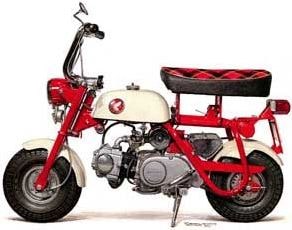
An early Z50A
Because the Z50A had no lighting, it some U.S. states It was not street legal, these were only a few, because in many U.S. states lighting was only mandatory when driving at night. To solve this problem, an updated model with lighting was created in 1969. A year later, a foot brake and a longer fender were added.
1970 model
In 1972 a completely new variant was introduced, it had different suspension, a different frame, a different tank and more.
The new variant
The Z50A was delivered until 1979, then came the successor: the Z50R. The Seat Fuel tankyou and Steering Handlebar were new. Lighting wasn’t on it anymore, which is why it wasn’t street legal.
A Z50R from 1980
Meanwhile, in Japan, the Monkey went in a completely different direction. Here the Monkey was much more suitable for street use and it its lighting. In 1974 came the Z50J. This one is a lot more modern and is very similar to the variants that are still being sold new in Japan.
Because it was very popular there, there have been a lot of versions of it. Below you will find a few. The total number of different monkeys is too large to describe in detail, as there have been many different colors and special editions. You can find it on http://www.ka-ha.de/mm-history.html.
Z50Y/J1

This was the first of the “modern” monkeys and had a 50ccengine with three foot gears and an automatic clutch, just like the previous models. it also had a overhead camshaft. In April 1974, it came on the market in Japan, Australia and a few European countries.
Z50JZ
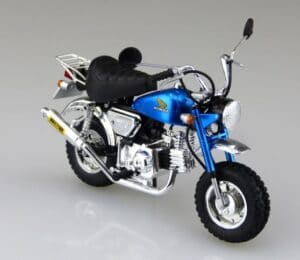
Four years after the Z50J1, the Z50JZ was introduced. A few things had been adjusted: the mudguards were now made of plastic instead of chrome, the Seat was different and so was the Fuel tank For the first time, the Monkey was now also available with four gears and a hand clutch, although the three-speed gearboxversion remained available. Furthermore, the block remained the same.
Gorilla

The Gorilla was intended as an improved version of the Monkey, but has actually always remained for sale alongside the “regular” Monkey. Thanks to a different tank and Seat it just had a coolappearance, but the frame was the same. Gorillas have mainly been available with four gears and a hand clutch, but in Germany you could also get them with 3-semi. The first model was released in 1978.
Z50JF
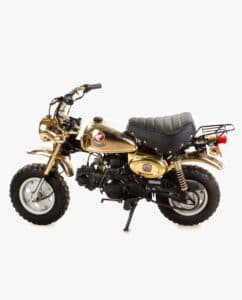
Apart from a few other colors, the Z50J remained much the same until 1984; Then came the Z50JF. Instead of the 2.6 hp that the previous versions delivered, the Monkey now had 3.1 hp. Wow! Three gears without clutch was no longer an option either. All the monkeys had four-speedfrom now on.
A special version of the JF: the Gold Monkey
ZB50/Monkey-R/Monkey-RT/AB22

Because many Monkey buyers also wanted something sportier, Honda introduced the AB22 in 1987. In Europe and America it was sold as a ZB and in Japan as sporty Monkey-R and the “touring” Monkey RT. All three were completely different from the Monkey as they knew him. The super-stiff tube frame with monoshock (one spring in the back), writing brake and separate tank and Seat, made Him drive very it The ZB had a three-speed gearbox semi-automatic, but the Japanese did get a four-speed and hand coupling. This Monkey model was the first with 12v CDI and a ball-bearing camshaft Another unique thing was the hydraulic Front Fork Normal Monkey forks feathers do, but hardly dampen. So the AB22 does.
Z50JN/JP

A small update came in 1991, when the Monkey and Gorilla got a 12v CDI instead of a 6v point ignition.
Monkey Baja
Only 3,000 copies of the Monkey Baja have been built. It is a very special variant of the Z50 with an off-road appearance. They are wanted and difficult to find, with the result that they are also quite expensive. There was even the even more extreme Monkey Baja Africa, with large tank and cool plastic.
A Monkey Baja Africa
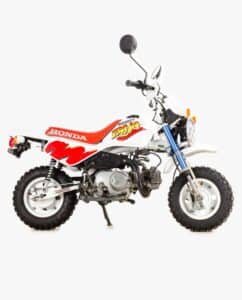
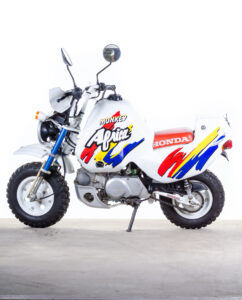
 Honda Gorilla
Honda Gorilla 
